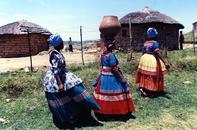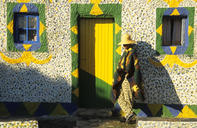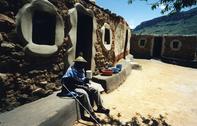Clan Cultural Divisions
At one level Moshoeshoe's Basotho were culturally and politically unified. Yet cultural divisions, based on clan- and kinship, were evident in the nation-building era and persist to today.

Administrative divisions - districts, sub districts, wards and villages, used and reinforced by the British administration of Basutoland, also persist, albeit only in Lesotho.
All Basotho belong to a clan, a social category whose members share a clan name that associates them with an animal totem or ancestor. Association is patrilineal, each person bearing the clan name of his or her father, paternal grandfather, etc. Unmarried mothers give their clan names to their child unless the father acknowledges paternity.
Basotho Village

According to Basotho legend, people first evolved from a marsh at a mythical place called Ntsuanatsatsi. They left the marsh in groups that became clans 'liboko', each of which was allocated an animal as god-protector. The totem for Moshoeshoe's clan, for example, was the crocodile 'koena'.
Totems were sacred, endowed with the quality of a molimo 'a god or invisible being', and had to be revered and feared. All members had to observe taboos and other usages in connection with the animal or object revered. The village 'motse' was the basic unit of administrative control. The number of inhabitants of a motse varied from a score to many hundreds.
Most of the adult male inhabitants were related along the paternal line, but men of different clans often lived in one motse. In earlier times, dwellings were built of mud reinforced with grass, plastered over a framework of saplings. About a century ago, with the influence of missionaries, thatched houses of dressed stone became very popular.
They were circular or rectangular, with one room or several. Where stones were not readily available, houses were made of mud blocks, and decorated with small stones stuck into the walls, or patterned with lines in the mud. Today many Basotho build rectangular houses with flat corrugated iron roofs.
Houses built entirely of corrugated iron are found in the burgeoning towns of Lesotho and the Free State. Many old Basotho villages were picturesque, blending in well with the environment. Set on raised terraces and rises, they left arable valleys and lowlands for agriculture. Efforts to aggregate settlements in the colonial 1950s and 60s forced people in Lesotho into larger villages.
Village Homesteads

As in the past, villages today consist of homesteads. Typically each has a husband and his wife and children, but many are headed by an unmarried mother, with three or four generations of children. The wide diversity in households today can be ascribed to the men's history as migrant workers on South African mines.
Previously, homesteads included married sons, their wives and young children. Some men with many wives had a homestead for each wife and her children, while others just had separate dwellings within a single extended homestead. Smaller homesteads had only one building, but some had a house, outhouses, storerooms and cooking huts.
These might be connected by a reed fence or mud walls. Friends and close relatives usually lived near to each other, their dwellings contiguous or, particularly in the lowlands of Lesotho, with enclosed gardens separating them. The layout of the rural village was based on a few basic principles, which might be modified according to personal choice and the demands of the topography.
In the past, the chief's private dwelling was in the centre of the main homestead, that of his principal wife next to it, and those of junior wives in rough order of seniority around them. The court 'lekhotla' was in front of his dwelling and next to it were the cattle kraal and stables.